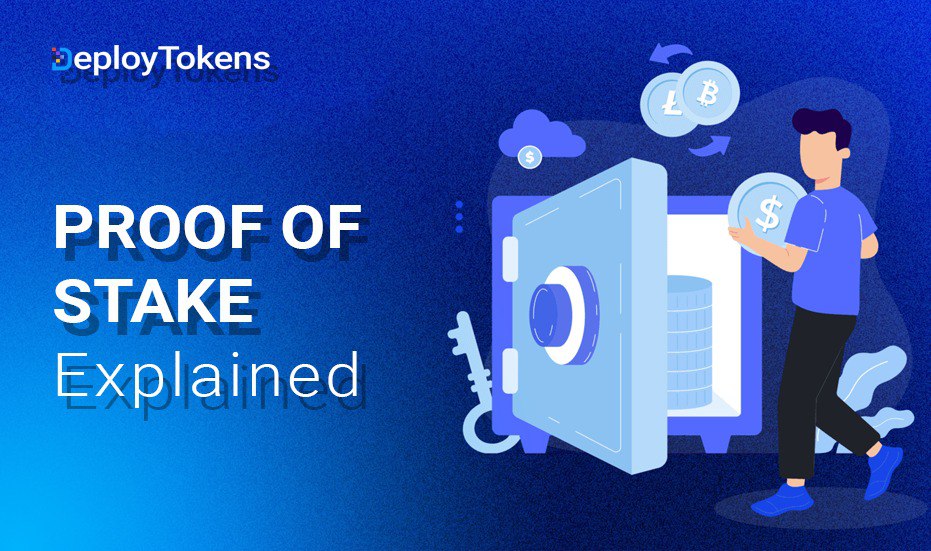Introduction: Why Proof of Stake Matters in 2025
Blockchain technology is evolving fast, and by 2025, Proof of Stake (PoS) is set to be a cornerstone of this revolution. If you’re new to crypto and wondering, “What is Proof of Stake?”—you’re in the right place. This simple guide will break it down, showing why PoS is shaping the future of digital currencies and how it’s easier on the planet than older methods.
At DeployTokens, we’re all about making blockchain clear and accessible. Whether you’re exploring token creation or just curious about crypto trends, understanding Proof of Stake in 2025 is a must. Let’s dive in!
What Is Proof of Stake? A Simple Explanation
Proof of Stake is a way blockchains agree on transactions and create new coins—without the energy-hungry machines of the past. In simple terms, it’s like a voting system where people “stake” their crypto to help run the network and earn rewards.
Unlike Bitcoin’s Proof of Work (PoW), which uses massive computing power, PoS relies on how much crypto you hold and are willing to lock up. For example:
- Stake 100 coins? You get a say in validating transactions and a chance at rewards.
- The more you stake, the bigger your role.
It’s all recorded on a blockchain—a secure digital ledger. Curious about the basics? Check Ethereum vs. Binance Smart Chain to see where PoS thrives.
How Does Proof of Stake Work? Step-by-Step
Here’s how PoS keeps blockchains running:
- Staking: You lock up coins in a wallet to support the network. Think of it as putting money in a savings account.
- Validation: Stakers (called validators) are chosen to check transactions—based on their stake size and other factors.
- Block Creation: Validators add verified transactions to the blockchain, creating new blocks.
- Rewards: You earn extra coins for helping out—proportional to your stake.
- Security: Smart contracts enforce the rules. Learn more in token generator vs. manual smart contracts.
It’s efficient and eco-friendly—perfect for 2025’s green focus. Want to try it? Start with creating a token on Ethereum.
Proof of Stake vs. Proof of Work: Key Differences
PoS and PoW are two ways to run a blockchain. Here’s how they compare:
- Proof of Work (PoW): Uses energy-intensive mining (e.g., Bitcoin). See Proof of Work vs. Proof of Stake.
- Proof of Stake (PoS): Relies on staked coins, not power-hungry rigs.
- Energy: PoW guzzles electricity; PoS is lightweight.
- Access: PoW needs pricey hardware; PoS just needs coins.
PoS is the future for many—greener and simpler.
Why Proof of Stake Is Big in 2025
By 2025, PoS is dominating for good reasons:
- Eco-Friendly: Cuts energy use by 99% compared to PoW.
- Scalability: Handles more transactions—vital for DeFi.
- Accessibility: Anyone with coins can stake—no tech skills needed.
- Adoption: Big networks like Ethereum 2.0 use it.
It’s a win for the planet and your wallet. Start small with how to create your first token.
Real-World Examples of Proof of Stake
Let’s see PoS in action:
- Ethereum 2.0: Switched to PoS in 2022, slashing energy use. Stake ETH on Ethereum.
- Cardano: A PoS pioneer, rewarding stakers with ADA coins.
- BNB Chain: Uses a PoS variant for fast, cheap transactions—try creating a BEP20 token.
- Solana: Blends PoS with speed, powering thousands of transactions.
These show PoS’s real-world power in 2025.
Benefits of Proof of Stake
Why choose PoS? Here’s the scoop:
- Energy Savings: No mining rigs—better for Earth.
- Passive Income: Earn rewards by staking.
- Security: Stakers have skin in the game, deterring attacks.
- Low Entry: No expensive gear—just coins.
Challenges of Proof of Stake
It’s not flawless:
- Rich Get Richer: Big stakers earn more, potentially centralizing power.
- Tech Learning: You need a wallet and basics—start with creating a token on Base.
- Risks: Staked coins can drop in value.
These are shrinking as PoS matures.
How to Get Started with Proof of Stake
Ready to stake? Here’s how:
- Pick a Blockchain: Try Ethereum or BNB Chain.
- Get Coins: Buy some (e.g., ETH, BNB) on an exchange.
- Set Up a Wallet: Use one like MetaMask—see how to create an ERC20 token.
- Stake: Lock coins via the network or a platform (e.g., Binance).
- Earn: Collect rewards over time.
Avoid pitfalls—read top 10 mistakes to avoid when launching a token.
The Future of Proof of Stake in 2025 and Beyond
PoS is just heating up. By 2025, it’s set to power more blockchains, from the metaverse to AI integration. Picture staking to support a virtual world or a smart city—all eco-friendly. It’s the backbone of a sustainable crypto future—explore the future of tokenization.
FAQ: Common Questions About Proof of Stake
Q: What’s the difference between PoS and PoW?
A: PoS uses staking, PoW uses mining—see Proof of Work vs. Proof of Stake.
Q: Is Proof of Stake safe?
A: Yes, if you stake wisely—avoid scams with crypto rug pulls.
Q: How do I stake coins?
A: Use a wallet and a PoS chain—start with our token creation guide.
Q: Why is PoS popular in 2025?
A: It’s green and scalable—details in future of tokenization.
Q: Can I lose money staking?
A: Yes, if coin value drops—plan with tokenomics.
Conclusion: Your Next Steps
Proof of Stake in 2025 blends efficiency with opportunity. For instance, it’s greener than ever, rewarding stakers while powering blockchains like Ethereum. Whether you’re new or a pro, PoS is your entry to crypto’s future. Therefore, visit DeployTokens.com, check our FAQ, or join us on Twitter and Telegram to dive in!
